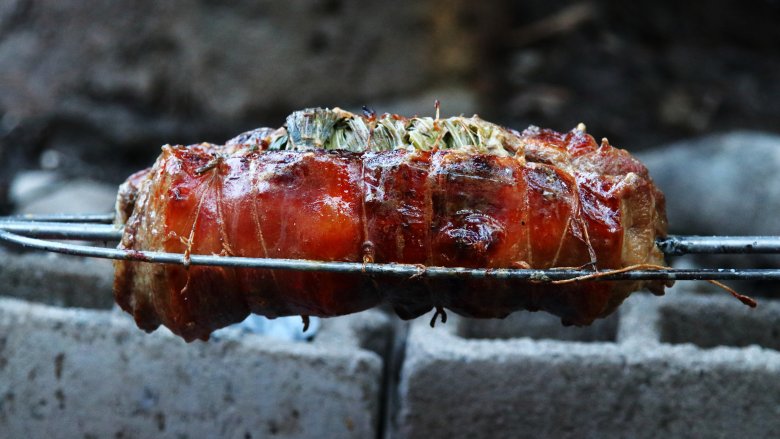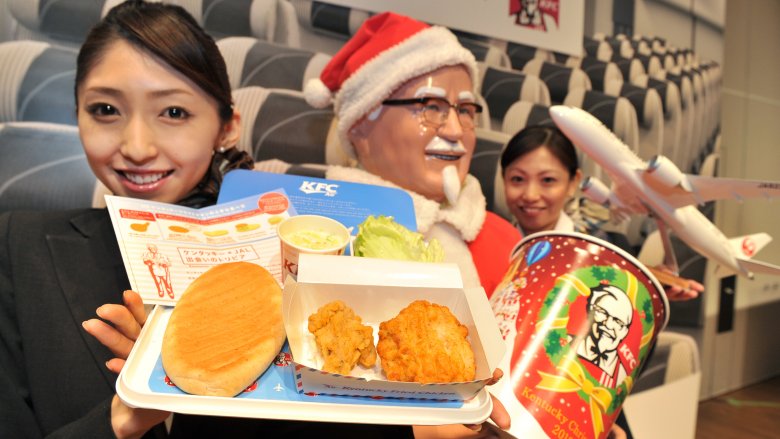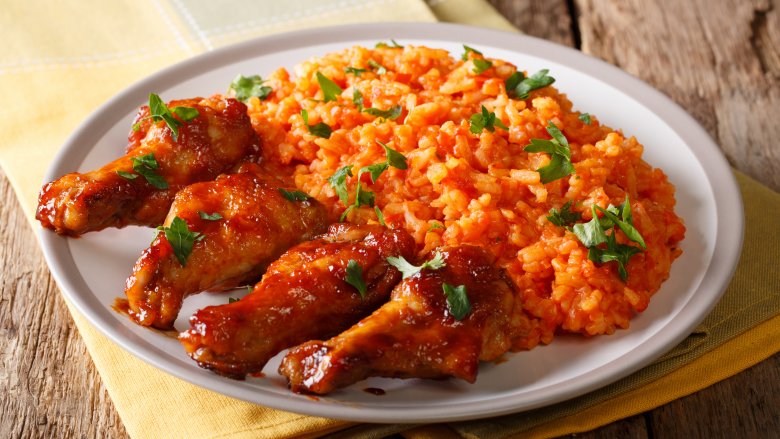What Christmas Dinner Looks Like Around The World
To those who celebrate Christmas, there is nothing more magical than the holiday season. Families and friends get together to celebrate the holiday, exchange gifts, and of course, chow down. Since it's celebrated in so many diverse countries around the world, Christmas traditions vary greatly not just from household to household, but also from country to country.
While there are many differences in how the Christmas holiday is celebrated, food is always a big part of the season, no matter where you are. Food, after all, is a timeless way of bringing people together, so it's fitting that the holiday is celebrated with a lavish feast, which really might be the best Christmas gift of all. The Christmas meals that families across the world whip up will have your mouth watering, and might even make you consider globetrotting next Christmas — or at least incorporating some of these international traditions into your own holiday season. Let's explore some of the yummiest Christmas dinners around the world.
Philippines
Christmas is a huge deal in the Philippines, with the holiday season traditionally starting as early as September. Once that month rolls around, retail stores and local parks start getting festive and putting up holiday displays. The official religious observation of the holiday kicks off closer to the big day, with Simbang Gabi, a series of pre-dawn church services on the nine days leading up to Christmas.
On Christmas Eve (or Noche Buena), families traditionally attend a midnight church service and then go home for a lavish feast. Now it's time to pig out — literally. One of the main attractions of a Filipino Christmas feast is lechon, a whole pig that is roasted until the skin turns red, crunchy, and delicious. Families who might not be able to afford an entire pig might instead celebrate with ham and queso de bola (Edam cheese). Another main course might be spaghetti — but not the kind you're used to. The Filipino version of the dish adds sugar to the recipe, and also tops it off with cheese and bright red hot dogs.
For those who remembered to save room for dessert, sweets abound. They can range from a simple fruit salad to tibok tibok, a pudding that derives its name from the Filipino word for "heartbeat" because, when it's cooked, the bubbles in it pulsate up and down. Leche flan, a year-round favorite, is also a must at holiday gatherings. This Filipino take on the Spanish flan is even richer, and adds condensed milk and extra egg yolks.
Finland
In Finland, family and friends gather on Christmas Eve for a festive meal. Fish is a staple of the Finnish diet, so it's no surprise that seafood plays a major role in the holiday feast. Salmon is eaten year-round, but it's also a Christmas favorite and can be served smoked or as gravlax, a sugar-and-salt cured dish served raw that is beloved in the Nordic countries. Other seafood dishes served at the Christmas table include powan, lutefisk (dried cod), pickled herring, and fish roe.
If fish doesn't strike your fancy, don't worry. Another popular Christmas dish in Finland is baked ham. The slow-baked dish is often paired with a homemade mustard. If there are any leftovers, they're put to good use in a post-Christmas pea soup. Lanttulaatikko (rutabaga casserole) is another holiday favorite.
Once you're done with all that, there are plenty of sweet treats to choose from. Desserts may include piparkakut (gingerbread cookies) and joulutorttu (plum jam filled pastries). Adults might wash this all down with a glass of glögi (mulled wine).
Japan
Traditionally, Japan is not a country that celebrates Christmas. While a small percentage of people in Japan are Christian, the two major religions in Japan are Shinto and Buddhism, which do not observe the holiday. That doesn't mean, however, that Christmas is totally forgotten in Japan. On December 25, many in Japan celebrate with a fried chicken meal from KFC. Roughly 3.6 million people order KFC on the holiday. December is one of the franchise's busiest months in that country, and people who don't pre-order the restaurant's Christmas dinner weeks in advance can find themselves waiting in line for hours.
How did KFC become synonymous with a holiday that isn't even widely celebrated in Japan? A marketing campaign in the 1970s, originally aimed at expats who missed turkey over the holidays, became a national phenomenon, and soon the "Party Barrel" for Christmas became a beloved tradition. "It filled a void," Joonas Rokka, an associate marketing professor at France's Emlyon Business School told the BBC. "There was no tradition of Christmas in Japan, and so KFC came in and said, this is what you should do on Christmas."
Today, Christmas meal boxes are filled with chicken, cake, and wine, and account for a third of KFC's yearly revenue in Japan.
Australia
While the dream of a white Christmas might not come true in the land down under, plenty of warm weather during the holiday season means a perfect opportunity to cook outdoors. While Aussies once prepared traditional meals in the kitchen, the Christmas trend since the 90s has been to cook outside on the barbecue and bask in the warm weather that Australia has to offer. Seafood abounds, with prawns being a big part of the Christmas menu. Seafood is so popular that the Sydney Fish Market hosts an annual 36-hour seafood marathon where vendors stay open for 36 hours straight until 5 p.m. on Christmas Eve so that patrons can get what they need for their feasts.
Mangoes are also part of the holiday tradition, and Christmas revelers are quite likely to sip a mango daiquiri while preparing the evening meal. Cherries are another fruity holiday staple in Australia, and it's common for a bowl of them to grace the Christmas table.
Puerto Rico
Christmas in Puerto Rico starts on December 15th with a series of dawn church services called Misas de Aguinaldo. The Christmas meal typically takes place on Christmas Eve, which is known as Nochebuena, where lechón (roast pork) is the traditional main course. This dish is often served up with a helping of arroz con gandules (rice and beans).
Since Puerto Rico is an island nation, it makes sense that seafood has long been a staple in the country, and many seafood dishes are served on the holiday. A Puerto Rican Christmas meal might be rounded out with bacalaitos fritos con bacalao guisado (salt cod fritters with cod salsa) or tostones con camarones guisados (plaintain fritters with stewed shrimp). For dessert, a family might feast on raspberry cream cake washed down with coquito, a Puerto Rican twist on eggnog. Coquito drinkers can't get too tipsy on the rum-based drink though, as many families go to a midnight church service called Misa de Gallo after the meal.
With so much happening on Christmas Eve, most people are exhausted by the time morning comes around and spend Christmas Day recovering from the Nochebuena festivities.
Russia
A lot of symbolism can be found in Russia's Christmas celebration. Rather than celebrating the holiday on December 25, members of the Russian Orthodox Church celebrate on January 7 as the church follows the Julian calendar. The Christmas dinner is served on sochevnik, or Christmas Eve. There are 12 courses served, one for each of Christ's apostles. A white tablecloth is laid out, representing the baby Jesus' swaddling clothes, with a white candle representing Christ being the light of the world placed on top.
Advent, the season leading up to Christmas, is a period of fasting in the Orthodox Church, so sochevnik is a meatless meal (the last meatless meal of the season, to be exact). Strict families also avoid fish, vegetable oil, and alcohol. The first course is a pudding called kutya which symbolizes unity and is made with grains and sweetened with honey, often eaten from a common bowl. Many families have a tradition of throwing a spoonful at the ceiling. If it sticks, it is thought to predict a plentiful honey harvest.
Families who allow fish might serve kulebyaka, a salmon turnover made with eggs, dill, and rice. Some families abstain from bread, but those who don't might serve sweet bread called bobal'ki or pagach, which is stuffed with potatoes or cabbage and dipped in honey and grated garlic. Strict households only serve vzvar for desert, a sweet drink used to welcome new arrivals which celebrates Christ's birth. Other families might serve pryaniki (gingerbread) or kolyadki, curd cheese-filled Christmas cookies made with rye flour and passed out to Christmas carolers.
Nigeria
Millions of people in Nigeria live in extreme poverty, so food is often on the simpler side. This, however, doesn't mean that the dishes aren't scrumptious; since eating outside the home is rare except among the wealthy, most home chefs are quite skilled at whipping up a delicious meal. Christmas dinner is special because it is spent with family. The food might not be too fancy, with many of the dishes served on Christmas being everyday foods served around the year, but it is yummy.
Nigerian fried rice, one of the country's most popular dishes, will almost certainly make an appearance and is made by stir-frying seasoned rice with meat, chicken, or prawns, and a blend of vegetables. Another party favorite is party jollof rice, a rice dish that is rich with tomatoes, peppers, and spices. Even the healthy-sounding vegetable sauce (a blend of chicken and assorted vegetables) is often served up with a helping of rice. Other popular rice dishes include egg fried rice and coconut rice.
Some traditional dishes that are not rice-centric include spaghetti jollof, spring rolls, tomato stew, and meat pies. There are also a whole slew of soups to choose from including goat meat pepper soup and yam and fish pepper soup. For dessert, you can expect Nigerian-style butter cake, and fruit cake, which is a Christmas favorite in the country.
Mexico
Christmas celebrations in Mexico are vibrant and full of color. Families typically gather on Noche Buena (Christmas Eve) and have a late meal together. The holiday meal might kick off with ensalada de Noche Buena, a Christmas salad with ingredients that vary based on preference and availability. Its base is typically lettuce and beets, but can also include pecans, peanuts, carrot, and fruits such as orange, pineapple, and pomegranate seeds. The colorful combination is not just a feast for the stomach, but for the eyes as well.
Tamales are another holiday staple, and are often made in large batches with the whole family pitching in. Tamale making is a party of its own called tamaladas. Other festive foods include bacalao (codfish), a pork or chicken hominy soup called pozole, and pavo (turkey). Dessert might include a sweet and colorful bread called rosca de reyes, and crispy fritters called buñuelos. Buñuelos are an extra special holiday treat, because after they are eaten you get to make a wish and smash your plate on the ground. This is all washed down with a piping hot mug of a hot fruit punch called ponche Navideño. This drink is made with tejocotes (Mexican hawthorn), guavas, apples, and other fruits. It's then topped with cinnamon and piloncillo (cane sugar) and might even be turned into an adult beverage with a bit of alcohol.
United Kingdom
British Christmas dinner traditions vary from household to household, but many families in the U.K. like to get things rolling with a seafood starter such as a shrimp cocktail. Aside from this, the traditional British dinner has quite a lot in common with a traditional Thanksgiving meal in the U.S, although the Brits skip the candied yams and also often opt for roasting their potatoes instead of mashing them. This might be a surprise to many who grew up with the classic British novel, A Christmas Carol, which portrays the center of the meal as a goose, not a turkey. While many British families did traditionally roast a goose (or a duck) for Christmas in the past, most families these days opt for a turkey instead.
Common side dishes boiled carrots, roasted parsnips, mashed turnips, and sprouts. The turkey is usually well-garnished, and can include cranberry sauce, bread sauce, and even pigs in blankets. For dessert, traditional dishes served up may include Yorkshire pudding and English trifle.
Poland
Polish families traditionally gather the night before Christmas for the Wigilia celebration. Wigilia is the most important celebration of the year, and typically includes only the immediate family. The meal consists of 12 courses and can last for hours, with presents only being opened after the meal is concluded. Wigilia is deeply rooted in tradition and symbolism. The meal begins when the first star appears in the night sky, and hay is strewn under the tablecloth to symbolize Jesus being born in a manger. The meal's twelve courses represent Jesus' twelve apostles, as well as the number of months in a year.
Most of the foods served for Wigilia are only made at Christmas, although some of them are Christmas-specific variations of traditional foods. According to custom, Christmas revelers abstain from meat on the holiday, so a lot of foods get a vegetarian spin. The meal often opens with a beetroot soup called barszcz (also called red borscht). While borscht is an everyday Polish food, the Christmas variation is special and adds uszka, which are tiny dumplings made from dried porcini and fried onion.
Other common dishes include pierogi (the Christmas version is often stuffed with cabbage, or sauerkraut and mushrooms) and cabbage rolls (usually stuffed with meat during the year but replaced with veggies for the holiday). Desserts include a cereal-like dish called kutia, and piernik (gingerbread), which is prepared in the days leading up to the holiday and served with plum preserves.










